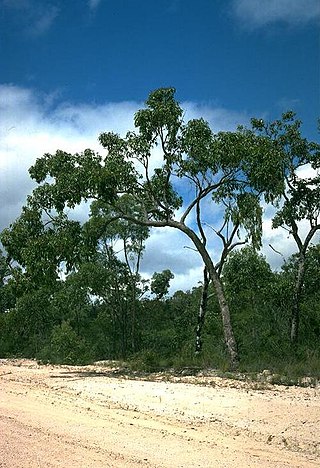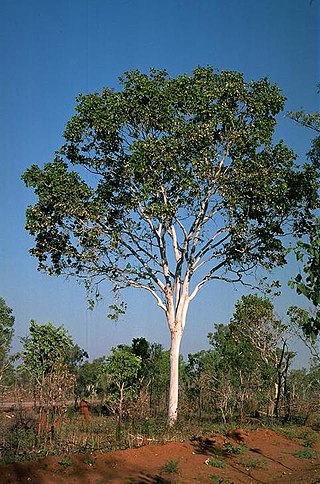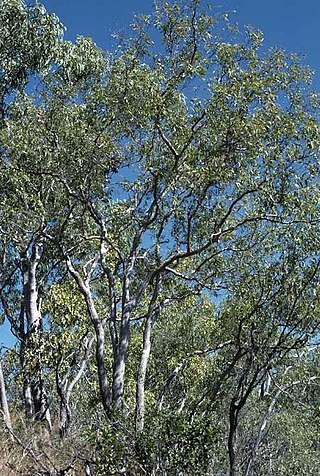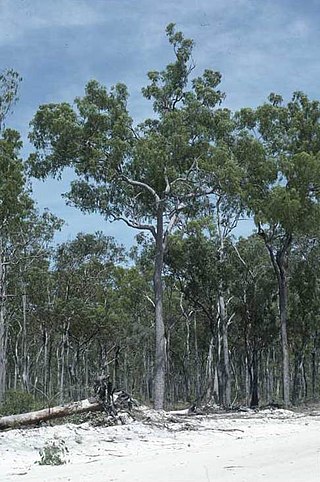
Corymbia abergiana, commonly known as range bloodwood or Rockingham Bay bloodwood, is a species of tree that is endemic to Queensland. It has rough bark on the trunk and larger branches, smooth bark on the smaller branches, lance-shaped adult leaves, flower buds in groups of seven, creamy white flowers and barrel-shaped fruit with a very thick rim.

Corymbia henryi, commonly known as large-leaved spotted gum, is a species of small to medium-sized tree that is endemic to north-eastern Australia. It has smooth, mottled bark, lance-shaped adult leaves, flower buds in groups of three, white or lemon yellow flowers and barrel-shaped to urn-shaped fruit.

Corymbia trachyphloia, commonly known as brown bloodwood, is a species of small to medium-sized tree that is endemic to eastern Australia. It has rough, tessellated bark on the trunk, often also on the larger branches, lance-shaped adult leaves, flower buds in groups of seven, white flowers and urn-shaped fruit.

Corymbia aspera, commonly known as rough-leaved ghost gum, rough leaf range gum, desert bloodwood, Brittle Range gum in Western Australia, or snappy gum in the Northern Territory is a species of tree that is endemic to northern Australia. It has smooth white bark, sometimes with a short stocking of rough bark near the base, a crown of sessile juvenile, heart-shaped or egg-shaped leaves, flower buds in groups of seven, creamy white flowers and cup-shaped, barrel-shaped or cylindrical fruit.

Corymbia collina, commonly known as silver-leaved bloodwood, is a species of tree that is endemic to Western Australia. It has thin patchy rough bark on some or all of the trunk, smooth white to pale grey bark above, lance-shaped to curved adult leaves, flower buds in groups of seven, creamy white flowers and barrel-shaped fruit.

Corymbia dichromophloia, commonly known as small-fruited bloodwood, variably-barked bloodwood or gum-topped bloodwood, is a species of tree that is endemic to northern Australia. It has smooth white bark sometimes with flaky bark on the trunk, lance-shaped adult leaves, flower buds usually in groups of seven, creamy white flowers and urn-shaped fruit.

Corymbia erythrophloia, commonly known as red bloodwood, variable-barked bloodwood, red-barked bloodwood or gum-topped bloodwood, is a species of tree that is endemic to Queensland. It has rough bark on the trunk and branches, egg-shaped or lance-shaped adult leaves, flower buds in groups of seven, creamy white flowers and urn-shaped to spherical fruit.

Corymbia foelscheana, commonly known as broad-leaved bloodwood, fan-leaved bloodwood or smooth-barked bloodwood, is a species of small tree that is endemic to northern Australia. It has thin, rough, tessellated bark on some or all of the trunk, smooth bark above, broadly egg-shaped to broadly lance- shaped adult leaves, flower buds usually in groups of seven, creamy white flowers and urn-shaped fruit.

Corymbia grandifolia, commonly known as cabbage gum, large-leaved cabbage gum and paper-fruited bloodwood, is a species of tree that is endemic to northern Australia. It has smooth bark, egg-shaped to broadly elliptic to lance-shaped adult leaves, flowers buds in groups of three or seven, creamy white flowers and cup-shaped to cylindrical fruit.
Corymbia clandestina, commonly known as Drummond Range bloodwood, is a species of small tree that is endemic to Queensland. It has rough, tessellated bark on the trunk and branches, lance-shaped adult leaves, flower buds in groups of seven, white flowers and urn-shaped to barrel-shaped fruit.
Corymbia arafurica is a species of tree that is endemic to the Northern Territory. It has smooth bark, lance-shaped adult leaves, flower buds in groups of three or seven, creamy white flowers and cylindrical to barrel-shaped fruit.

Corymbia jacobsiana, commonly known as Jacob's bloodwood or stringybark bloodwood, is a species of tree that is endemic to the Northern Territory. It has rough, stringy bark on the trunk and branches, lance-shaped to elliptical or curved adult leaves, flower buds in groups of three or seven, creamy white flowers and urn-shaped fruit.

Corymbia kombolgiensis, commonly known as scarp gum or paper-fruited bloodwood, is a species of small tree that is endemic to the Northern Territory. It has smooth bark, sometimes with rough, tessellated bark near the base, linear to narrow lance-shaped adult leaves, flower buds usually in groups of seven, white flowers and cylindrical to barrel-shaped fruit.
Corymbia lamprophylla, commonly known as shiny-leaved bloodwood, is a species of tree that is endemic to central Queensland. It has rough, tessellated bark on the trunk and larger branches, lance-shaped adult leaves, flower buds in groups of seven, creamy white flowers and urn-shaped fruit.

Corymbia latifolia, commonly known as round-leaved bloodwood, round leaf bloodwood, wubam and other names in indigenous languages, is a species of tree that is endemic to northern Australia. It has thin, rough bark over part or all of the trunk, smooth bark above, triangular or broadly egg-shaped adult leaves, flower buds in groups of seven, creamy white flowers and urn-shaped fruit.

Corymbia nesophila, commonly known as Melville Island bloodwood, is a species of tree that is endemic to northern Australia. It has rough, tessellated bark on the trunk and branches, lance-shaped or curved adult leaves, flower buds in groups of seven, creamy white flowers and urn-shaped fruit.
Corymbia polysciada, commonly known as apple gum, paper-fruited bloodwood or bolomin, is a species of tree that is endemic to the Top End of the Northern Territory. It has rough, tessellated bark on some or all or the trunk, smooth bark above, egg-shaped to broadly lance-shaped adult leaves, flower buds in groups of seven, creamy white flowers and cup-shaped, cylindrical or barrel-shaped from on long pedicels.
Corymbia porrecta, commonly known as grey bloodwood, is a species of small tree that is endemic to the Northern Territory. It has rough, tessellated bark on the trunk and branches, broadly lance-shaped to egg-shaped adult leaves, flower buds usually in groups of seven, creamy white flowers and urn-shaped to barrel-shaped fruit.
Corymbia rhodops, commonly known as red-throated bloodwood, is a species of tree that is endemic to Queensland. It has rough, tessellated bark on the trunk and larger branches, lance-shaped adult leaves, flower buds in groups of seven, creamy white flowers with a red centre, and urn-shaped to barrel-shaped fruit.

Corymbia umbonata, commonly known as rusty bloodwood, is a species of tree that is endemic to the Top End of the Northern Territory. It has thin, rough bark on the trunk, often also the branches, lance-shaped or curved adult leaves, flower buds in groups of seven, creamy white flowers and urn-shaped fruit.















